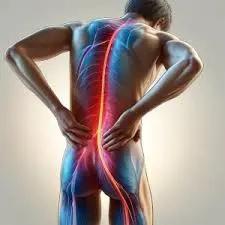Sciatica can be a debilitating condition that affects millions of individuals worldwide. The nerve-related pain caused by sciatica, radiates from the lower back down through the leg. However, with the right approach and understanding, it is possible to manage and alleviate the symptoms of sciatica. In this comprehensive guide, we will delve into the causes, symptoms, and strategies for tackling this common condition.
Understanding sciatica
Sciatica is a term used to describe the symptoms that arise when the sciatic nerve, the longest and thickest nerve in the body, becomes irritated or compressed. This nerve originates in the lower back and extends down through the buttocks and legs, branching out to the feet. The sciatic nerve comes from nerve roots in your lower spine. Compression or irritation of the sciatic nerve can lead to a range of symptoms, including pain, tingling, numbness, and even muscle weakness.
Causes of sciatica
Sciatica can be triggered by a variety of underlying conditions, the most common of which is a herniated or bulging disc in the spine. Other potential causes include spinal stenosis, degenerative disc disease, bone spurs, pregnancy, and injuries to the lower back or leg. Understanding the specific cause of your sciatica is crucial for developing an effective treatment plan.
Symptoms of sciatica
The main symptom of sciatica is a shooting, burning, or electric-like pain that radiates from the lower back down through the buttocks, thigh, and leg. Patients may also experience tingling, numbness, or muscle weakness in the affected leg. The severity of symptoms can vary greatly, with some individuals experiencing mild discomfort and others dealing with debilitating pain that interferes with daily activities.
Diagnosing sciatica
Diagnosing sciatica typically involves a combination of a medical history, physical examination, and diagnostic tests. Your healthcare provider will likely start by asking about your symptoms, any underlying conditions, and any recent injuries or accidents you may have had. They will then perform a physical examination, which may include tests such as the straight-leg raise test to assess nerve function.
Imaging tests
In some cases, your healthcare provider may recommend imaging tests to help identify the underlying cause of your sciatica. These tests may include:
- X-rays: Spinal X-rays can reveal structural changes in the spine, such as bone spurs or a herniated disc
- Magnetic Resonance Imaging (MRI): An MRI provides detailed images of the spinal structures, including the discs, nerves, and surrounding tissues, helping to identify the source of the compression or irritation
- Computed Tomography (CT) Scan: A CT scan can also be used to visualise the spine and identify any abnormalities that may be contributing to your sciatica
Electrodiagnostic tests
In some cases, your healthcare provider may also recommend electrodiagnostic tests, such as electromyography (EMG) and nerve conduction studies, to assess the function of the affected nerve and confirm the diagnosis of sciatica.
Self-care strategies for sciatica pain relief
While seeking professional care is essential for managing sciatica, several self-care strategies can help alleviate the symptoms and promote healing. These include:
Rest and gentle movement
During the initial stages of sciatica, it’s important to balance rest and gentle movement. Avoid long periods of sitting or lying down, as this can make the condition worse. Instead, engage in light, low-impact activities such as walking, swimming, or gentle stretching to maintain mobility and prevent further injury.
Ice and heat therapy
Applying ice packs or cold compresses to the affected area can help reduce inflammation and ease the pain of sciatica. After the initial inflammation has subsided, you can switch to a heating pad or warm baths to promote blood flow and muscle relaxation.
Over-the-counter medications
Non-steroidal anti-inflammatory drugs (NSAIDs), such as ibuprofen or naproxen, can help alleviate sciatic nerve pain and inflammation. Always follow the dosage instructions and consult your healthcare provider before starting any new medication.
Stretching and exercise
Incorporating specific stretching exercises into your daily routine can help alleviate sciatica symptoms and prevent future flare-ups. Focus on exercises that target the lower back, hips, and legs, such as:
- Piriformis stretches
- Hamstring stretches
- Core-strengthening exercises
- Low-impact aerobic activities like walking or cycling
Consult with a physical therapist or healthcare provider to ensure you are performing the sciatica exercises correctly and safely.
Posture and ergonomic adjustments
Good posture and making ergonomic adjustments to your work environment can help reduce the strain on your spine and alleviate sciatica symptoms. This may include using a supportive chair, adjusting your computer monitor height, and taking regular breaks to stretch and move.
Treatment options
If self-care strategies do not provide sufficient relief or your symptoms worsen, it’s important to seek professional medical advice and treatment. Your healthcare provider may recommend the following treatments:
Medications
In addition to over-the-counter painkillers, your healthcare provider may prescribe stronger medications to relieve sciatica pain, such as:
- Prescription-strength NSAIDs
- Muscle relaxants
- Neuropathic pain medications
- Corticosteroids
These medications can help reduce inflammation, relax muscle spasms, and alleviate neuropathic pain associated with sciatica.
Physical therapy
A physical therapist can design a customized treatment plan to help alleviate your sciatica symptoms and address the underlying cause of the condition. This may include:
- Targeted stretches and exercises
- Manual therapy techniques, such as massage or spinal manipulation
- Modalities like ultrasound or electrical stimulation
- Advice on posture, ergonomics, and activity modification
Regular physical therapy sessions can be an effective way to manage sciatica and prevent future flare-ups.
Spinal injections
In some cases, your healthcare provider may recommend spinal injections, such as epidural steroid injections, to help reduce inflammation and alleviate pain. These injections are administered under local anaesthesia and can provide temporary relief for individuals with severe or persistent sciatica.
Surgery
While surgery is usually considered a last resort for sciatica, it may be recommended in cases where conservative treatments have not been effective, or if there is evidence of significant nerve damage or spinal instability. Common surgical interventions for sciatica include:
- Discectomy: Removal of a portion of a herniated or bulging disc that is compressing the nerve
- Laminectomy: Removal of a portion of the vertebral bone (lamina) to create more space for the nerve
- Spinal fusion: Fusing two or more vertebrae together to stabilise the spine and reduce nerve compression
Your healthcare provider will discuss the potential risks and benefits of any surgical intervention before recommending this course of action.
Preventing sciatica recurrence
It’s important to take steps to prevent future episodes of sciatica. This may include:
Maintaining a healthy lifestyle
Maintaining a healthy weight, engaging in regular exercise, and practicing good posture can all help reduce the strain on your spine and lower the risk of sciatica recurrence.
Strengthening the core
Incorporating core-strengthening exercises can help improve lower back pain in the lumbar spine and your overall stability, reducing the likelihood of future sciatica episodes.
Proper lifting techniques
When lifting heavy objects, be sure to use proper form, keep your back straight, and engage your leg muscles to avoid straining your lower back.
Managing underlying conditions
If you have an underlying condition, such as degenerative disc disease or spinal stenosis, working closely with your healthcare provider to manage these conditions can help prevent sciatica flare-ups.
Conclusion
Sciatica can be a challenging condition, but with the right approach, it is possible to manage the symptoms and promote healing. By understanding the causes, seeking appropriate medical care, and incorporating self-care strategies, you can take control of your health and improve your quality of life. Remember, early intervention and a comprehensive treatment plan are key to achieving long-lasting relief and preventing future sciatica episodes.
Sources
- Sciatica: What It Is, Causes, Symptoms, Treatment & Pain Relief
- Sciatica – Diagnosis and treatment – Mayo Clinic
- Sciatica – NHS
Medical Disclaimer
NowPatient has taken all reasonable steps to ensure that all material is factually accurate, complete, and current. However, the knowledge and experience of a qualified healthcare professional should always be sought after instead of using the information on this page. Before taking any drug, you should always speak to your doctor or another qualified healthcare provider.
The information provided here about medications is subject to change and is not meant to include all uses, precautions, warnings, directions, drug interactions, allergic reactions, or negative effects. The absence of warnings or other information for a particular medication does not imply that the medication or medication combination is appropriate for all patients or for all possible purposes.









